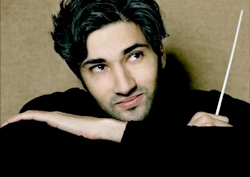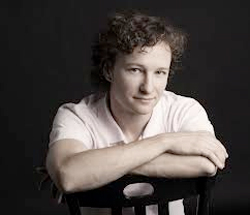by Nicholas Jones

The brilliant German conductor David Afkham, returning to Blossom where he debuted in July of 2011, brought fire and freshness to a familiar program of music by Beethoven and Schubert. A former Dudamel conducting fellow, Afkham shares with his mentor a focus on the details coupled with an unflagging sense of the big picture.
The opening piece was Beethoven’s stormy “Coriolanus” overture (in C minor: the rest of the program moved to the sunnier key of C major). While there was a little rhythmic uncertainty as the piece began, the conductor soon established control. Afkham has a sure hold on how important contrast is to Beethoven: the overture unmistakably showed the contrast between the angular theme that depicts the overbearing Roman general with its abrupt leaps and terrifying silences, and the gentler tune usually associated with the pleadings of Coriolanus’s mother.
The Beethoven C major piano concerto (called, wrongly, the first—actually the second) is from ten years earlier than “Coriolanus.” Appropriately, it is marked by youthful bravado and virtuosity. It was performed stunningly by the German pianist Martin Helmchen – like David Afkham, just entering his third decade, and looking a bit like the gallant young Beethoven.
Helmchen has a large repertory of tones, colors, and articulations, and he uses them to great effect. He opened the concerto with a warm graciousness that steadily built to grander tones. The snappy gestures of sixteenth notes and grace notes that accompany the main theme of the first movement were played with mallet-like precision and power.

The cadenzas were flashy, of course, but thoughtfully so: the twists and turns were consistently engaging (there’s a famous deceptive trill that sounds as if it’s the end, but turns out to be only the beginning of a whole new section).
In the second movement, Helmchen showed his love of playing chamber music in his interplay with the smaller orchestra, especially with the oboes and clarinets. His lyrical playing was fluid without losing articulation and structure.
The third movement was played at a swift tempo, but Helmchen’s extraordinary command of technique took no prisoners. Angular, percussive, even manic in the “Turkish” F minor sections, the playing had a perfection that avoided the preciousness of that term. It was unmistakably “right” – and yet it was exciting for being on the edge of “right.”. At one point, I wasn’t sure if we were listening to Beethoven, Monk, or Shostakovich.
After intermission, the orchestra played the Schubert “Great” C major symphony, written when the composer was just short of thirty. The orchestra’s sound was as balanced as I have ever heard them in Blossom. The string sound was clear and precise, big without being raucous or overbearing. When we needed to hear the winds and brass, Afkham kept the strings to an extraordinary pianissimo—not an easy feat in the excitement of Schubert’s energetic rhythms.
Solo bows at the end for the winds included, of course, the horns who led off the hour-long journey of this amazing symphony, the trumpets with their amazing tonguing on the repeated notes, and the oboes and clarinets who feature so gracefully in the hymn-like second movement. Unusually for a classical symphony, a deserved bow went to the trombones, whose rich and expressive playing anchored the dark sea-swells underneath the restless surface of this wonderful work.
The C major is indeed “great” in many ways, not the least for its “heavenly length.” But to my ears, the fourth movement extends that length a little more than the young Schubert could sustain. At any rate, Saturday evening’s performance seemed to lose a little of its focus by the end.
But it did not seem that anyone in the crowd minded. Generous cheers from the lawn (well-populated on such a gorgeous evening) and from the largely-filled pavilion greeted the conductor and orchestra at the end.
Nicholas Jones is Professor of English at Oberlin College and a keen amateur musician.
Published on ClevelandClassical.com August 27, 2013
Click here for a printable version of this article.



